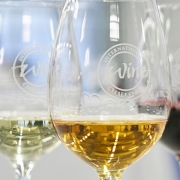THE 8 COFFEE TRENDS WE EXPECT TO SEE MORE OF IN 2020
1. ICED COFFEE IS SO HOT RIGHT NOW
Iced coffee isn’t new, but it’s certainly having a revival right now.
According to recent research by the Allegra World Coffee Portal USA, cold coffee (in all its many forms) is growing at 7.3% per year, almost double the growth rate of hot coffee (4.6%). This is consistent with data from the Square Australian Coffee Report, which also shows impressive growth in the cold segment.
What’s changed?
In the past, iced coffee drinks were usually loaded with sugar & flavours – aimed squarely at a younger, less coffee focussed audience. Now, as the popularity of unsweetened iced coffee varieties takes off, this category is no longer seen as a novelty, but a legitimate option for grown-ups.
Leading the way is cold brew. Around the world, this simple brewing method is turning into a mainstream hit, thanks to its smooth flavour profile & wide variety of serving options.
2. ALMOND MILK DOMINATES, OAT MILK IS THE ONE TO WATCH
Remember the days when cow’s milk & soy were the only two options in Australian cafes…
Well those days are gone, long gone.
In 2019, Almond milk officially took over from Soy as the most popular milk alternative in cafes. In fact, milk alternatives are growing right across the board. According to figures from the retail/grocery market, ‘Nut Milks’ (including Almond) are growing at 8%pa, while Soy is still growing at 5.9%.
Not only that, but customers are increasingly asking for a huge range of other alternatives: coconut, rice, macadamia – the list goes on.
Among all these options, the one to watch is Oat Milk.
According to the Café Pulse report, Oat sales have increased a massive 425% since June 2017. While Oat milk is still quite new in Australia, it has quickly become a staple in US & UK cafes thanks to its similarity in flavour to real cow’s milk.
Marcus Fehlberg from The Alternative Dairy Co explains “All the data indicates that non-diary milks are going to keep growing for the next 5 years +. A big part of that is because customers are now choosing them not only because they need to have them for dietary reasons, but also because they want to have them.”
3. BLACK (COFFEE) IS THE NEW BLACK
The news for real milk gets worse.
Customers aren’t just opting for milk alternatives, increasingly they’re also choosing to skip milk altogether.
As tastes shift towards lighter roast coffee, and brewing methods such as batch brew filter & cold brew become more widely available in cafes, we are starting to see some movement in the numbers.
In our own espresso bar in Manly Vale, we’ve seen an increase in ‘black’ coffee sales (Long Black, Espresso & Filter) of 52% per year over the last 2 years.
In addition, during 2019 sales of our ‘Filter Roast’ varieties grew 20% faster than the exact same coffees roasted for Espresso.
Of course, in Australia, milk-based coffees are still the overwhelming majority at the moment – but it seems things are starting to change…
4. SUSTAINABLE PACKAGING IS THE NEW NORMAL
In Australia, the concern around disposable cups reached a flashpoint in 2017, when the ABC highlighted the problem in their ‘War on Waste’ TV special.
Overnight, demand for reusable cups spiked, with many unable to keep up with demand.
What’s even more interesting, is that this wasn’t just a fad.

Data Source: Google Trends
After the initial hype faded, interest in reusable cups continues to grow year on year as many customers make permanent changes to their coffee drinking habits.
This is only one example, in 2019 we’ve seen a number of new products & programs designed to reduce waste, including:
- Recyclable Cups, like Detpak’s RecycleMe program – which we’re involved with at Seven Miles.
- Swap programs, like the Huskee Swapprogram
- Reusable Straws
- Coffee Bag Recycling, like our programwith Terracycle, which has already saved 8 tonnes of CO2 emissions.
So, what’s the next sustainability trend we expect to see?
Energy Use
Recent research from our Coffee Science & Education Centre showed that energy use made up a whopping 53% of the carbon footprint of an average café (compared to 0.6% contributed by disposable cups).

Average cafe CO2 footprint breakdown
A big contributor is the energy used by the espresso machine. We’re already seeing some interesting developments in this space. Italian espresso machine manufacturer Carimali showed off their new ‘boilerless’ technology at HOST Milan 2019, which they claim uses 90% less energy than a traditional machine.
Adam Carr from our Coffee Science & Education Centre sums it up “With all the focus on disposable cups, we’ve overlooked the elephant in the room when it comes to café sustainability. Reducing the impact of energy use is a huge opportunity for us to make a real difference.”
5. ESPRESSO GRINDERS GET A WHOLE LOT MORE ACCURATE
The last few years have seen timer-based grinders, like the Mazzer E series & the Mythos One dominate the café landscape.
The problem with these grinders has always been consistency, particularly because specialty baristas demand a precise dose of ground coffee – as low as 0.1g between doses.
To work around the variation produced by timer-based grinders many baristas resort to manually weighing every dose – a time-consuming process.
To combat this, ‘grind by weight’ grinders (like the Mythos 2.0) started to hit the market in 2019. The first generation of this technology was interesting but was ultimately let down by their slow speed between doses of coffee.
However, with the latest grinders due to hit the market in 2020, it looks like baristas might not have to choose between speed & accuracy.
Leading the charge of these next generation grinders is the brand new Mahlkonig E65S GbW, which is due to be available in 2020.
It has a lot of impressive features, but the combination of speed & accuracy is something baristas have we’ve been waiting a long time for.
6. AUTOMATED ESPRESSO IS COMING TO CAFES…SLOWLY
Last year, we wrote about how automation is changing the way baristas work.
Since then, we’ve seen technology like the Puqpress & the Ubermilk appearing in cafes all around the country at a remarkable rate.
While that trend seems certain to continue, 2020 looks to be a year of consolidation when it comes to espresso automation.
Yes, we’ve seen some interesting concepts, like the AMS (Auto Milk Steamer) prototype from La Marzocco & the Perfect Moose steamer, but we’re not expecting to see the bigger disruptive coffee trends emerging in the next 12 months.
Looking further into the future, automatic machines like the Eversys Cameo c’2 continue to blur the lines between traditional & automatic with every software upgrade. It’s not happening yet, but it may not long until this style of machine starts to find a place in everyday cafes.
Another way espresso automation is coming to life is through self-service technology.
Machines like the Scanomat Topbrewer open up the possibility of entirely new business models with their simple interface & impressive quality. Their latest model includes flash chilling, allowing venues to offer espresso coffees, iced coffee & even Nitro cold brew all from the same tap.
7. CAFES GO CASHLESS
With the popularity of tap-and-go payments increasing every year, cash is becoming less relevant as time goes by.
According to 2018 research by payment service provider Square, cashless transactions make up more than half (54%) of all payments in cafes.
Some food businesses have decided that they can serve customers more quickly & reduce risk by eliminating cash altogether. One example is the legendary Lune Croissanterie in Melbourne, who recently went cashless in both of their locations.
Is it a good thing?
Well, no one likes paying merchant fees. However, when you consider all the extra time spent counting cash, going to the bank, handing over change – it starts to make you think…
8. DELIVERY IS HERE TO STAY, WHETHER WE LIKE IT OR NOT…
Despite their massive fees, food delivery services like Ubereats, Menulog & Deliveroo have seen some big growth over the last few years.
It’s not just limited to full meals, people are now ordering smaller items like ice-cream, juices and coffees using these services.
Overseas, some coffee businesses are even setting up delivery-centric or delivery-only ‘dark kitchens’ to keep costs down. One example is the Luckin Coffee chain in China, which has opened over 3000 stores since 2018 using a delivery-focussed business model to get the upper hand on Starbucks.
Would a delivery-first business model like Luckin Coffee work in Australia?
Given the differences in economics, customer behaviour & culture – it’s really hard to say for sure.
What we do know is that the café business in Australia keeps changing every year. While we can’t all jump on every bandwagon that comes along, it’s good to know what’s on the horizon so that we can adapt.
Source: https://www.sevenmiles.com.au/editorial/coffee-trends-2020/












